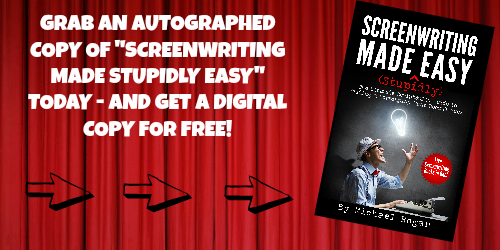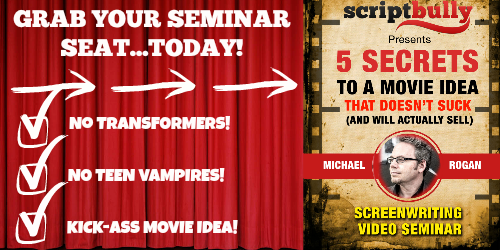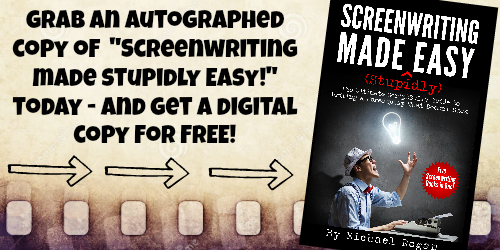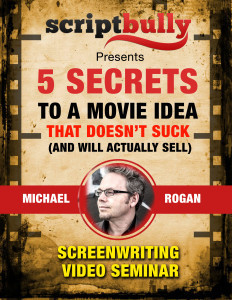Michael Rogan's Blog, page 7
April 23, 2015
10 Most Frustrating Screenwriting Format Questions Answered

I don’t think there’s any BIGGER source of stress for screenwriters – aside from having to watch a Michael Bay movie (again) – than screenwriting format.
And it’s understandable, screenwriting format looks like some foreign, arcane language. (Something Indiana Jones would use to find the Ark of the Convenant.)
And nothing SCREAMS “I’m an amateur” quicker than ill-advised screenwriting format.
So with that, here are some answers to the TEN most FAQ around screenwriting format. (Just remember the MOST important formatting strategy is a kick-ass screenplay.)
Screenwriting Format FAQ #1: Won’t screenwriting software, such as Final Draft, handle most of my script software needs?
Yes and no.
Software WILL handle the mind-numbingly boring task of handling your margins and spacing. (Trust me, you don’t want to do this.)
But other more nuanced decisions like whether a scene is INT. or an EXT. – as denoted in a scene’s slugline. (Example: INT. STARBUCKS – DAY.) Or how to properly format thigns like montages, flashbacks, phone calls…require a more deft hand.
Screenwriting Format FAQ #2: I know INT. means interior and EXT. means exterior. But what about things like cars or stadiums or patios?
So…it helps to remember what this format direction is for. It lets the crew make a PLAN for which scenes will require indoor or outdoor lighting.
 This is why a car, even a convertible, is ALWAYS an INT. And a stadium or a restaurant patio is an EXT. It’s a matter of lighting – not so much geography.
This is why a car, even a convertible, is ALWAYS an INT. And a stadium or a restaurant patio is an EXT. It’s a matter of lighting – not so much geography.
One additional thing to remember, if you’re writing a low-budget script – and as a newbie you probably should be – keep your number of locations to a minimum. (They get expensive.)
Screenwriting Format FAQ #3: How specific do I have to get in the slugline? (Can I just put Starbucks in the slug, or do I need to be more detailed.)
It really depends on the scene. If your scene is set at Yankee Stadium, and your big action sequence takes place between shortstop and third base…then we’ll need more information than just EXT. YANKEE STADIUM – DAY.
What you want to AVOID is needless slugline description. (It bores script readers…and when they get bored they skip.)
If there’s ONE PLACE where you can go really crazy with your slugline description it would be that opening, table-setting image of yoru script. You know that…
EXT. SPAIN – SANTIAGO DE COMPOSTELA – CATEHDRAL ENTRANCE – DAY.
Screenwriting Format FAQ #4: How do I handle close ups? (Or any other camera movement?)
First off, the way NOT to handle is to do something like WE PULL BACK TO REVEAL or WE MOVE IN. (Don’t do this. Please.)
Instead the better way to do a close up is something like: CLOSE ON DARTH MAUL or CLOSE – DARTH MAUL’S SPIKY HEAD. Just remember this is a TRUE close up. (Not just a medium shot, where the camera takes in the subject from the waist up.) If you wanna just do a med. shot then simply refer to the character in the description and the crew will get it.
As for other camera movement, let’s say we’re following a character through a crowded subway. Then instead of writing EVERY single subway car as a separate slugline, we can simply do…
Popeye Doyle sees the Frenchman on the move.
MOVING WITH POPEYE.
Screenwriting Format FAQ #5: How do I handle sound effects?
Good, I’m glad you asked this. Because this is one area I see screwed up all the time in scripts that I read.
The rule goes like this:
1) If the sound is organic and doesn’t require an effect – such as knocking, laughing, talking, cheering – then no need to do anything special.
2) If the SOUND happens onscreen AND requires a SOUND EFFECT then we capitalize BOTH the sound AND the object that created it.
Bob pulls out his smartphone. Clicks a button, without looking. Jane’s FAREWELL VOICE MAIL blares through the speaker of his APPLE IPHONE as he grips his Gin and Tonic.
3) If the SOUND happens offscreen, then we NEED to CAP the sound AND the object that created it.
Jack works to crack the safe. A SHOTGUN PUMPS behind him.
Screenwriting Format FAQ #6: How do I know when I should use a FADE OUT or a CUT TO or a DISSOLVE.
So, what you’re talking about are transitions. And this is probably the area where you have the most leeway. (Remember Peter Jackson used 14 FADE OUTs in “Return of the King.”)
But…
Here are some general guidelines:
1) Try to ONLY use FADE IN at the beginning of your script. And FADE OUT at the end. (Unless you have a compelling reason to do break this rule.)
2) CUT TOs are kinda old-fashioned. (But if you need an urgent cut from one scene to another it’s okay to use it.) Just make sure you put the CUT TO at the far right end before the description.
3) DISSOLVES are great for showing time having passed. (Just try to avoid the RIPPLE DISSOLVE – this is the cheesy Scooby Doo effect from the 70s – unless you’re using it for comic effect.)
Screenwriting Format FAQ #7: Phone Calls
Ah yes, phone calls. Was wondering when you were gonna get around to asking about those.
They are actually pretty easy all you gotta do is set up your two characters talking on the phone – and then throw in an INTERCUT direction.
INT. ITALY – PADUA – ROMEO’S APARTMENT – DAY.
Romeo sitting in his flat in Padua. He picks up the phone. Dials.
ROMEO
Why have you been ignoring my calls?
INT. ITALY – PADUA – STARBUCKS – DAY.
Juliet, very clearly on a date with a HANSOME MERCHANT, begrudingly answers her cell phone.
JULIET
I don’t see a ring on this finger.
INTERCUT phone conversation.
And that’s all there is to it. Super, super easy.
Screenwriting Format FAQ #8: How about flashbacks and dream sequences?
First off, let me give you this warning. Flashbacks and dream sequences are inherently uncinematic. (Mostly becuase they TAKE US out of the narrative.)
But there are time when you just gotta have ’em. In that case, there are basically two ways to do them. Either at the beginning of the slugline or at the end.
FLASHBACK – INT. KREMLIN – SECRET MAP ROOM – DAY.
or…
INT. KREMLIN – SECRET MAP ROOM – DAY. [DREAM SEQUENCE]
Either one works. Just be sure you REALLY need them. (Especially the dream sequences, those tend to piss off script readers.)
Screenwriting Format FAQ #9: Considering how you responded to FLASHBACKS, I’m almost scared to ask about MONTAGES.
As well you should. 
But seriously, the question you want to ask yourself about MONTAGES is whether you want to use a device that was ridiculed in “The Naked Gun.”
But if you’re gonna write a montage, and I beg you NOT to, then here’s the BEST way to do it:
AROUND NEW YORK CITY – MONTAGE
President Obama and President Putin stare at each other in defiance in the UN General Assembly Room. Suddenly Putin begins to smile…Obama breaks out in laughter.
Obama and Putin good-naturedly arm wrestle each other in a Brooklyn pizza joint.
Obama and Putin play the life-size piano at FAO Schwartz, as a nervous secret service detail looks on.
Screenwriting Format FAQ #10: What’s the BIGGEST script formatting issue you come across?
To be honest with you, the biggest formatting issue doesn’t have anything to do with interiors, or phone calls, or dialogue, or ripple dissolves.
It’s the length of paragraphs.
There used to be a rule about keeping all paragraphs no longer than four lines. (I think this has now been reduced to three.)
It’s just really hard to READ a screenplay. And seeing a HUGE block of text on a page, with no white space, is just really disheartening. (And one thing you don’t want a reader eying your script is disheartened.)
So as you plow your way through the trials and tribulations of screenplay format, just remember screenwriting format is about creating rules of engagement to make things clear and easy to digest for development folks. (Not help you get some Good Housekeeping screenwriting seal of approval.) Focus on that…and you can put as many MONTAGEs and RIPPLE DISSOLVEs and CUT TOs as you want.
The post 10 Most Frustrating Screenwriting Format Questions Answered appeared first on ScriptBully.
10 Super-Common (But Confusing) Screenwriting Format Questions Answered

I don’t think there’s any BIGGER source of stress for screenwriters – aside from having to watch a Michael Bay movie (again) – than screenwriting format.
And it’s understandable, screenwriting format looks like some foreign, arcane language. (Something Indiana Jones would use to find the Ark of the Convenant.)
And nothing SCREAMS “I’m an amateur” quicker than ill-advised screenwriting format.
So with that, here are some answers to the TEN most FAQ around screenwriting format. (Just remember the MOST important formatting strategy is a kick-ass screenplay.)
Screenwriting Format FAQ #1: Won’t screenwriting software, such as Final Draft, handle most of my script software needs?
Yes and no.
Software WILL handle the mind-numbingly boring task of handling your margins and spacing. (Trust me, you don’t want to do this.)
But other more nuanced decisions like whether a scene is INT. or an EXT. – as denoted in a scene’s slugline. (Example: INT. STARBUCKS – DAY.) Or how to properly format thigns like montages, flashbacks, phone calls…require a more deft hand.
Screenwriting Format FAQ #2: I know INT. means interior and EXT. means exterior. But what about things like cars or stadiums or patios?
So…it helps to remember what this format direction is for. It lets the crew make a PLAN for which scenes will require indoor or outdoor lighting.
This is why a car, even a convertible, is ALWAYS an INT. And a stadium or a restaurant patio is an EXT. It’s a matter of lighting – not so much geography.
One additional thing to remember, if you’re writing a low-budget script – and as a newbie you probably should be – keep your number of locations to a minimum. (They get expensive.)
Screenwriting Format FAQ #3: How specific do I have to get in the slugline? (Can I just put Starbucks in the slug, or do I need to be more detailed.)
It really depends on the scene. If your scene is set at Yankee Stadium, and your big action sequence takes place between shortstop and third base…then we’ll need more information than just EXT. YANKEE STADIUM – DAY.
What you want to AVOID is needless slugline description. (It bores script readers…and when they get bored they skip.)
If there’s ONE PLACE where you can go really crazy with your slugline description it would be that opening, table-setting image of yoru script. You know that…
EXT. SPAIN – SANTIAGO DE COMPOSTELA – CATEHDRAL ENTRANCE – DAY.
Screenwriting Format FAQ #4: How do I handle close ups? (Or any other camera movement?)
First off, the way NOT to handle is to do something like WE PULL BACK TO REVEAL or WE MOVE IN. (Don’t do this. Please.)
Instead the better way to do a close up is something like: CLOSE ON DARTH MAUL or CLOSE – DARTH MAUL’S SPIKY HEAD. Just remember this is a TRUE close up. (Not just a medium shot, where the camera takes in the subject from the waist up.) If you wanna just do a med. shot then simply refer to the character in the description and the crew will get it.
As for other camera movement, let’s say we’re following a character through a crowded subway. Then instead of writing EVERY single subway car as a separate slugline, we can simply do…
Popeye Doyle sees the Frenchman on the move.
MOVING WITH POPEYE.
Screenwriting Format FAQ #5: How do I handle sound effects?
Good, I’m glad you asked this. Because this is one area I see screwed up all the time in scripts that I read.
The rule goes like this:
1) If the sound is organic and doesn’t require an effect – such as knocking, laughing, talking, cheering – then no need to do anything special.
2) If the SOUND happens onscreen AND requires a SOUND EFFECT then we capitalize BOTH the sound AND the object that created it.
Bob pulls out his smartphone. Clicks a button, without looking. Jane’s FAREWELL VOICE MAIL blares through the speaker of his APPLE IPHONE as he grips his Gin and Tonic.
3) If the SOUND happens offscreen, then we NEED to CAP the sound AND the object that created it.
Jack works to crack the safe. A SHOTGUN PUMPS behind him.
Screenwriting Format FAQ #6: How do I know when I should use a FADE OUT or a CUT TO or a DISSOLVE.
So, what you’re talking about are transitions. And this is probably the area where you have the most leeway. (Remember Peter Jackson used 14 FADE OUTs in “Return of the King.”)
But…
Here are some general guidelines:
1) Try to ONLY use FADE IN at the beginning of your script. And FADE OUT at the end. (Unless you have a compelling reason to do break this rule.)
2) CUT TOs are kinda old-fashioned. (But if you need an urgent cut from one scene to another it’s okay to use it.) Just make sure you put the CUT TO at the far right end before the description.
3) DISSOLVES are great for showing time having passed. (Just try to avoid the RIPPLE DISSOLVE – this is the cheesy Scooby Doo effect from the 70s – unless you’re using it for comic effect.)
Screenwriting Format FAQ #7: Phone Calls
Ah yes, phone calls. Was wondering when you were gonna get around to asking about those.
They are actually pretty easy all you gotta do is set up your two characters talking on the phone – and then throw in an INTERCUT direction.
INT. ITALY – PADUA – ROMEO’S APARTMENT – DAY.
Romeo sitting in his flat in Padua. He picks up the phone. Dials.
ROMEO
Why have you been ignoring my calls?
INT. ITALY – PADUA – STARBUCKS – DAY.
Juliet, very clearly on a date with a HANSOME MERCHANT, begrudingly answers her cell phone.
JULIET
I don’t see a ring on this finger.
INTERCUT phone conversation.
And that’s all there is to it. Super, super easy.
Screenwriting Format FAQ #8: How about flashbacks and dream sequences?
First off, let me give you this warning. Flashbacks and dream sequences are inherently uncinematic. (Mostly becuase they TAKE US out of the narrative.)
But there are time when you just gotta have ‘em. In that case, there are basically two ways to do them. Either at the beginning of the slugline or at the end.
FLASHBACK – INT. KREMLIN – SECRET MAP ROOM – DAY.
or…
INT. KREMLIN – SECRET MAP ROOM – DAY. [DREAM SEQUENCE]
Either one works. Just be sure you REALLY need them. (Especially the dream sequences, those tend to piss off script readers.)
Screenwriting Format FAQ #9: Considering how you responded to FLASHBACKS, I’m almost scared to ask about MONTAGES.
As well you should. 
But seriously, the question you want to ask yourself about MONTAGES is whether you want to use a device that was ridiculed in “The Naked Gun.”
But if you’re gonna write a montage, and I beg you NOT to, then here’s the BEST way to do it:
AROUND NEW YORK CITY – MONTAGE
President Obama and President Putin stare at each other in defiance in the UN General Assembly Room. Suddenly Putin begins to smile…Obama breaks out in laughter.
Obama and Putin good-naturedly arm wrestle each other in a Brooklyn pizza joint.
Obama and Putin play the life-size piano at FAO Schwartz, as a nervous secret service detail looks on.
Screenwriting Format FAQ #10: What’s the BIGGEST script formatting issue you come across?
To be honest with you, the biggest formatting issue doesn’t have anything to do with interiors, or phone calls, or dialogue, or ripple dissolves.
It’s the length of paragraphs.
There used to be a rule about keeping all paragraphs no longer than four lines. (I think this has now been reduced to three.)
It’s just really hard to READ a screenplay. And seeing a HUGE block of text on a page, with no white space, is just really disheartening. (And one thing you don’t want a reader eying your script is disheartened.)
So as you plow your way through the trials and tribulations of screenplay format, just remember screenwriting format is about creating rules of engagement to make things clear and easy to digest for development folks. (Not help you get some Good Housekeeping screenwriting seal of approval.) Focus on that…and you can put as many MONTAGEs and RIPPLE DISSOLVEs and CUT TOs as you want.
The post 10 Super-Common (But Confusing) Screenwriting Format Questions Answered appeared first on ScriptBully.
March 2, 2015
Pitchfest Q&A: Are Screenplay Pitchfests a Scam?

In this installment of screenwriting Q&A we go over a commonly asked question that comes up with screenwriting competitions and conferences: is a screenplay contest pitchfest a total scam to make money – or will they actually lead to results?
“Hey ScriptBully:
I’m getting ready to go to a writer conference and they offer script pitchfests and I was just wondering whether it’s worth the extra $50…or should i save the money and by another screenwriting book. (Namely yours.)
-James
Turlock, Calif.
Hey James,
Thanks for the question. So are pitchfests scams? Without knowing exactly WHICH pitchfest you’re gonna take part in, here are a couple of thoughts:
Screenwriting Pitchfest Tip #1: If You Can’t Afford It, Don’t Do It
If spending $50 or even $100 on pitching will force you to sell a spare kidney, then definitely pass. The CHANCES of your pitch actually leading to an immediate financial boon are quite small. (And besides you’ll need that kidney later.)
Screenwriting Pitchfest Tip #2: If Your Idea Sucks, Definitely Don’t Do It
Pitchfests are not about getting a critique of your story or get access to constructive feedback on your project. It’s ABOUT enticing story development folks – and agents and managers – into wanting to know more.
And how do you KNOW if your idea sucks? Pitch it to everyone you know. (And don’t know.) If total strangers go “Cool Idea” then you’re on to something.
And really, a pitchfest, is like an American Idol audition. (It’s a cattle call, with mostly untalented wannabes…but…they are STILL looking for genuine talent.)
Screenwriting Pitchfest Tip #3: If You Can Keep Expectations Low, They Can Be Beneficial
I think the REAL benefit of a pitchfest is forcing you to break your story in a digestible chunks…and then communicating that with a stranger who may or may not change your life.
This is great for a couple of reasons:
1) It’s pretty damn scary. (And most people don’t do scary.)
2) Pitching is a skill…and one that only gets better when you do it alot.
3) You’ll MEET industry folks who you might be able to query later on.
4) You’ll hear LOTS of other pitches from fellow writers. (This alone will make you a better writer.
Screenwriting Pitchfest Tip #4: Make Sure You Got a 1-Sheet
Okay, so suppose the agent or story exec LOVES your pitch. Well, the next thing they will ask for is a 1-sheet.
A 1-sheet is simply a 1-page breakdown of your entire story. And it BEHOOVES you to bring it WITH YOU to the pitchefest.
This is because:
1) They have something to take back to the office with them.
2) They will remember you, because you are the 1% of the other writers who’ll have them.
And as hard as you work on your pitch, is how hard you should work on your 1-sheet. It’s gotta be good and exciting and SCREAM marketability.
And then if they like the 1-sheet. They might just ASK to read your script. And suddenly you are in a different stratosphere.
You are a very small fish in a very large pond. But it’s a pond that can change your life overnight.
Got a burning screenwriting question? Please let us know over at our Facebook Page with the #askscriptbully tag. Thanks!
The post Pitchfest Q&A: Are Screenplay Pitchfests a Scam? appeared first on ScriptBully.
Screenwriting Q&A: Are Screenplay Pitchfests a Scam?

In this installment of screenwriting Q&A we go over a commonly asked question: are those screenplay contest pitchfests a scam to make money – or will they actually lead to results.
I’m getting ready to go to a writer conference and they offer script pitchfests and I was just wondering whether it’s worth the extra $50…or should i save the money and by another screenwriting book. (Namely yours.)
-James
Turlock, Calif.
Hey James,
Thanks for the question. So are pitchfests scams? Without knowing exactly WHICH pitchfest you’re gonna take part in, here are a couple of thoughts:
Screenwriting Pitchfest Tip #1: If You Can’t Afford It, Don’t Do It
If spending $50 or even $100 on pitching will force you to sell a spare kidney, then definitely pass. The CHANCES of your pitch actually leading to an immediate financial boon are quite small. (And besides you’ll need that kidney later.)
Screenwriting Pitchfest Tip #2: If Your Idea Sucks, Definitely Don’t Do It
Pitchfests are not about getting a critique of your story or get access to constructive feedback on your project. It’s ABOUT enticing story development folks – and agents and managers – into wanting to know more.
And how do you KNOW if your idea sucks? Pitch it to everyone you know. (And don’t know.) If total strangers go “Cool Idea” then you’re on to something.
And really, a pitchfest, is like an American Idol audition. (It’s a cattle call, with mostly untalented wannabes…but…they are STILL looking for genuine talent.)
Screenwriting Pitchfest Tip #3: If You Can Keep Expectations Low, They Can Be Beneficial
I think the REAL benefit of a pitchfest is forcing you to break your story in a digestible chunks…and then communicating that with a stranger who may or may not change your life.
This is great for a couple of reasons:
1) It’s pretty damn scary. (And most people don’t do scary.)
2) Pitching is a skill…and one that only gets better when you do it alot.
3) You’ll MEET industry folks who you might be able to query later on.
4) You’ll hear LOTS of other pitches from fellow writers. (This alone will make you a better writer.
Screenwriting Pitchfest Tip #4: Make Sure You Got a 1-Sheet
Okay, so suppose the agent or story exec LOVES your pitch. Well, the next thing they will ask for is a 1-sheet.
A 1-sheet is simply a 1-page breakdown of your entire story. And it BEHOOVES you to bring it WITH YOU to the pitchefest.
This is because:
1) They have something to take back to the office with them.
2) They will remember you, because you are the 1% of the other writers who’ll have them.
And as hard as you work on your pitch, is how hard you should work on your 1-sheet. It’s gotta be good and exciting and SCREAM marketability.
And then if they like the 1-sheet. They might just ASK to read your script. And suddenly you are in a different stratosphere.
You are a very small fish in a very large pond. But it’s a pond that can change your life overnight.
Got a burning screenwriting question? Please let us know over at our Facebook Page with the #askscriptbully. Thanks!
February 24, 2015
Screenwriting Agents | How the Hell Do Ya Get an Agent?

[What’s up, screenwriting ninjas? In this little edition of Ask ScriptBully we’re gonna tackle that most vexing element of the quest for how to sell a screenplay…and that is how the HELL to get one of them screenwriting agents.]
“Hey Michael, So I had a question I know you’ve heard before. But how the hell do you get a screenwriting agent? I’ve got a screenplay which I feel is in pretty decent shape, and is ready to be sent out to agents, but I’m not sure how to get started. Thanks!”
-Matt R.
Hey Matt,
Thanks for the question. Even though I feel the question is the wrong one.
Your screenwriting aim SHOULD not be how to get an agent. It should be HOW to get your career started. (And in my experience the two hardly ever go hand-in-hand.)
That’s because most screenwriting agents simply don’t have the time or motivation to help you get started. You are a pain in the ass to them. (You take time, you have no idea how to write for the marketplace, and you’re a probably control-freak about your words.)
Sad, but true
However…an agent who represents an up-and-coming actor or director would absolutely be somebody you’d want to pursue.
And as for HOW to “get” that agent – simply send them an email telling them that you’ve got the absolute perfect vehicle for their client.
Just be sure it’s SOMETHING that will help them expand their career. (Not the same old shit they’re doing now.)
Wayne Gretzky, before he became the greatest hockey player in the universe, was instructed by his dad to watch hockey games on TV, and track the movement of the puck with a pen and paper.
Because, as Gretzky senior put it, the key is NOT knowing where the puck is. (It’s knowing where the puck WILL be.)
Know where the client of your targeted agent WANTS to be. (Usually walking a red carpet in February.) And you’ll find yourself with more than an agent…you’ll find yourself a career.
The post Screenwriting Agents | How the Hell Do Ya Get an Agent? appeared first on ScriptBully.
Screenwriting Q&A: How the Hell Do I Get an Agent?

[What’s up screenwriting ninjas. In this little edition of Ask ScriptBully we’re gonna tackle that most frequent of screenwriting FAQs… and it comes from Matt R. in Provo, Utah.]
“Hey Michael, So I had a question I know you’ve heard before. But how the hell do you get a screenwriting agent? I’ve got a screenplay which I feel is in pretty decent shape, and is ready to be sent out to agents, but I’m not sure how to get started. Thanks!”
-Matt R.
Hey Matt,
Thanks for the question. Even though I feel the question is the wrong one.
Your screenwriting aim SHOULD not be how to get an agent. It should be HOW to get your career started. (And in my experience the two hardly ever go hand-in-hand.)
That’s because most writer agents simply don’t have the time or motivation to help you get started. You are a pain in the ass to them. (You take time, you have no idea how to write for the marketplace, and you’re a probably control-freak about your words.)
Sad, but true
However…an agent who represents an up-and-coming actor or director would absolutely be somebody you’d want to pursue.
And as for HOW to “get” that agent – simply send them an email telling them that you’ve got the absolute perfect vehicle for their client.
Just be sure it’s SOMETHING that will help them expand their career. (Not the same old shit they’re doing now.)
Wayne Gretzky, before he became the greatest hockey player in the universe, was instructed by his dad to watch hockey games on TV, and track the movement of the puck with a pen and paper.
Because, as Gretzky senior put it, the key is NOT knowing where the puck is. (It’s knowing where the puck WILL be.)
Know where the client of your targeted agent WANTS to be. (Usually walking a red carpet in February.) And you’ll find yourself with more than an agent…you’ll find yourself a career.
February 3, 2015
Do Screenwriters Have to Live in L.A. to Make It as a Screenwriter?

It’s probably the #1 screenwriting question I get – aside from why do people STILL give M. Night Shyamalan movie to make movies…
Do I have to live in Los Angeles to make it as a screenwriter?
And so, in this video, I tackle this most controversial and debated topic. (I also offer 4 strategies that screenwriters who CAN’T move to Southern California can use to break into the film biz.)
WHAT do you think? Do you think screenwriters need to live in L.A.? Let us know in the comments below!
January 9, 2015
Screenwriting Hack: How to Write a Screenplay That Sucks Like Twilight

There may be no better way to learn how to write a screenplay that sucks than study the masters. And, in this case, the masters are the fine creative team that brought you “Twilight.”
So, for educational purposes only, here is step-by-step guide to “How to Write a Screenplay That Sucks Like Twilight..” as performed by a couple of sock puppets.
Screenwriting Q&A: How Do I Write a Screenplay Flashback That Doesn’t Suck?

Ah…yes. Good old flashbacks. The bane of every screenwriter’s existence. Many a well-meaning screenplay has careened off the road and ended up in the screenwriting ditch by pulling out a worn-out, super-cheesy flashback sequence.
That’s because flashbacks are, by their nature, inherently “unreal.” But sometimes you need them.
So what do you do?
Well, that’s we cover in this Ask ScriptBully video in which I offer a few strategies for penning a screenplay flashback that doesn’t royally suck.
Screenwriting Hack: How to Write a Script With a Killer Page One

When you’re learning how to write a script, sometimes it’s best to keep things simple.
Write a great page one, so you can get them to page two. (Rinse and repeat.)
And I can tell you, as a former script reader, I may have been contractually obligated to read an entire script, but I knew RIGHT from Page One whether I was in good hands for the next 105 pages or so.
So, in this installment of Screenwriting Hacks, I recorded a short video breaking down some tips on how to write a script with a kick-ass awesome page one:






